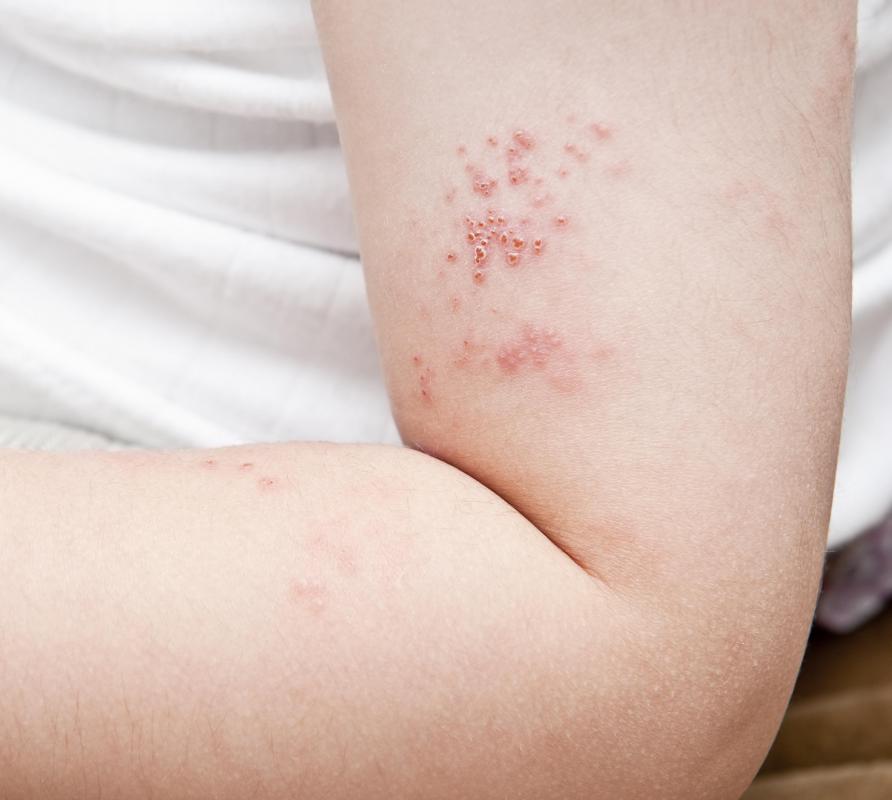At WiseGEEK, we're committed to delivering accurate, trustworthy information. Our expert-authored content is rigorously fact-checked and sourced from credible authorities. Discover how we uphold the highest standards in providing you with reliable knowledge.
What is Bullous Pemphigoid?
Bullous pemphigoid is an autoimmune condition that typically affects people late in life, usually those 60 or older. It causes outbreaks of blisters, which most often occur on the mid body or on the legs. There can be numbers of blisters together that may ultimately burst and scab over, and then disappear. People may have recurrence of blisters in various parts of the body, and the disease can take many years to resolve without treatment.
As mentioned, bullous pemphigoid is an autoimmune condition. What appears to happen is that the body turns on the top layers of skin and begins to attack them. This results in the formation of the blisters. The disease can extend to the mucous membranes too, and the body’s attack on itself may cause blisters to form in the mouth, which can be particularly uncomfortable.

The basic symptoms of bullous pemphigoid are presence of the blisters, which are also called bullae. People may have a few blisters or they can have many, and the degree to which the blisters are prominent may vary. Some people may more notice a rash, but not so much a rash made of large blisters. Other symptoms people might have include itching, open sores, redness of the skin, sore mouth and gums, lesions in the mouth, and rash that looks like hives.

If people have a rash they should see a doctor, since rashes could also indicate conditions like shingles. After taking an exam, doctors usually can test for bullous pemphigoid fairly simply. They do this by removing a small amount of fluid from one or more blisters, which is then analyzed by a lab to look for the presence of antibodies, suggesting the skin is fighting itself.

Once diagnosed, treatment tends to be very standard. Most people begin by taking an oral corticosteroid, and possibly using a corticosteroid cream on blistered areas. The trouble with this is that it is an especially risky one women. Long-term use of corticosteroids is associated with quicker development of osteoporosis. Osteoporosis is already a risk for post-menopausal women, who would be most likely to get bullous pemphigoid. A good physician can discuss options with women that may help minimize this risk. Sometimes other medications called immunosuppresants are chosen instead if and when they seem most efficacious.

The other issue with treatment is that while the rash remains, it is much more likely to create infection. When the immune response is suppressed, as it is with corticosteroids and immunosuppressants, infection is more likely. Those with this disease need to be vigilant if they notice any lesions becoming infected, feeling hot to the touch, having red streaks that radiate away from the lesion or seeming filled with pus. People should make certain to report these symptoms or development of fever to doctors.

The good news about this disease is that treatment does help it improve, though this can still take time. Many people are symptom free within a couple of years of starting a drug regimen. In the most severe cases it can take up to five years to recover from this illness. To avoid creating more irritation of the skin, people should be especially careful about using sunscreen if they have any outdoor exposure. Those who have sores in the mouth might also be helped by modifying diet slightly to avoid hard or sharp foods or highly acidic foods like citrus or vinegar.
AS FEATURED ON:
AS FEATURED ON:















Discuss this Article
Post your comments